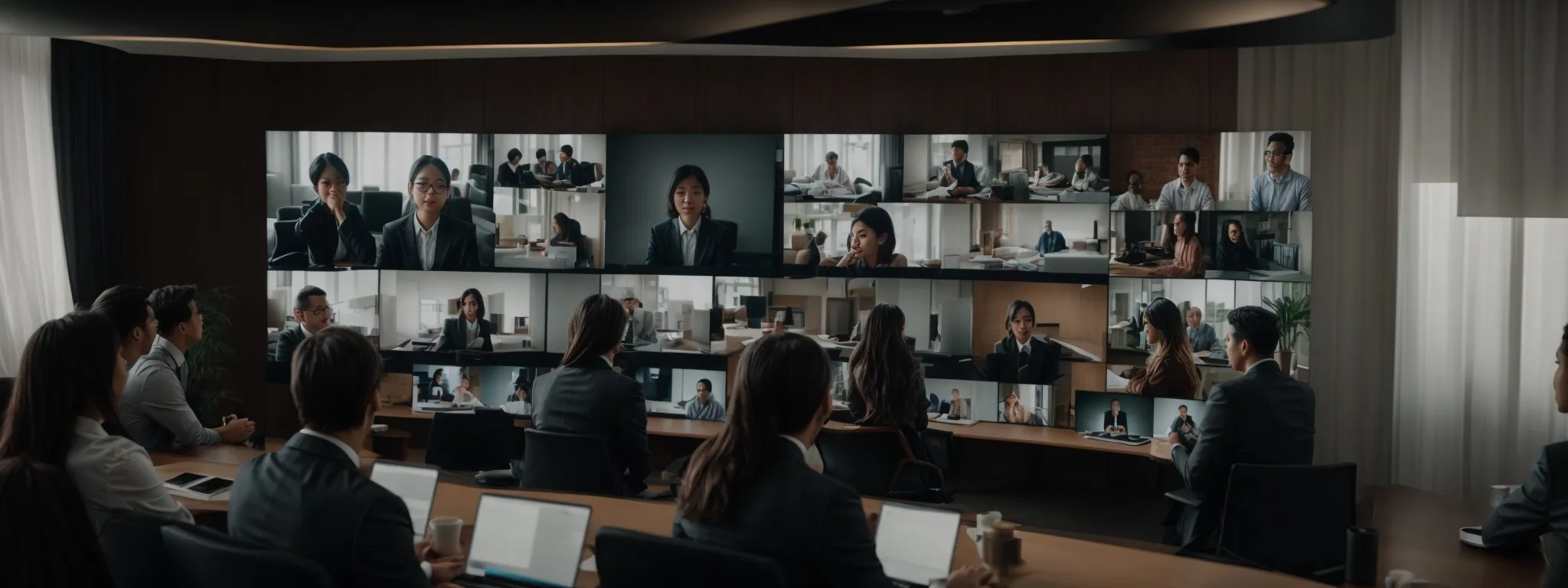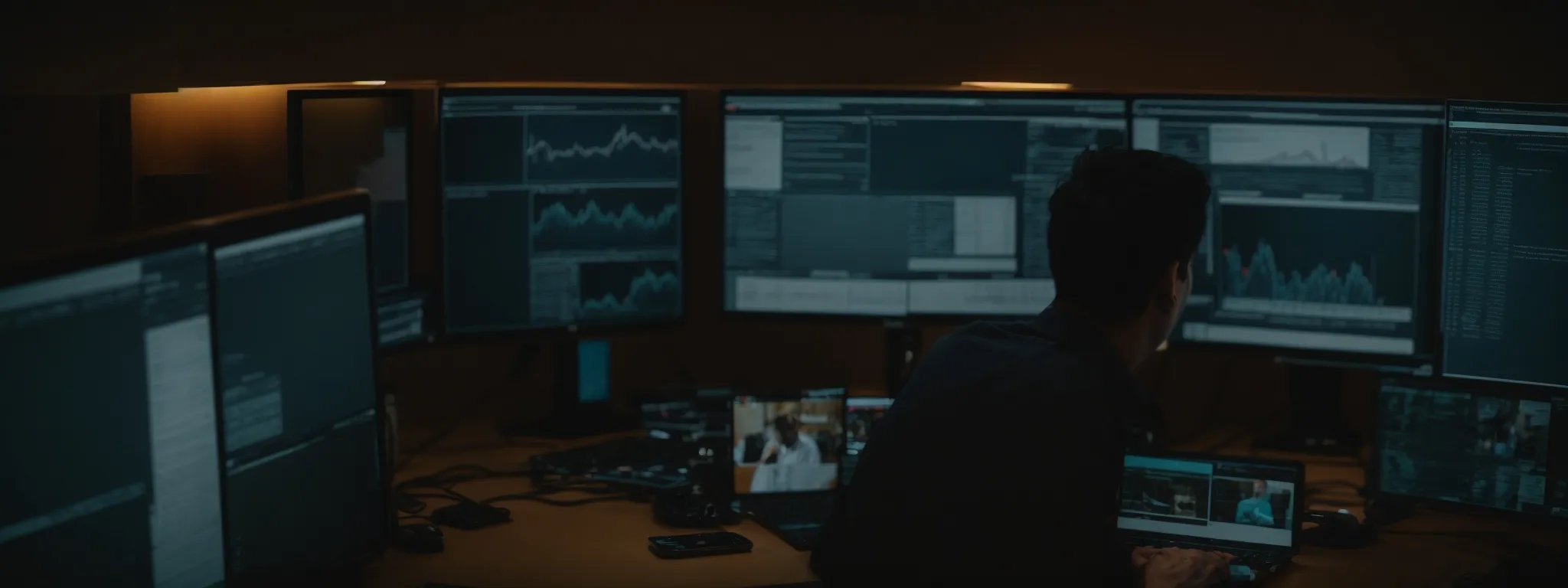Virtual Meetings: Top Video Conferencing Tools
Essential Video Conferencing Tools for Effective Virtual Meetings In today’s digitally driven landscape, video conferencing tools are indispensable for forging meaningful connections across virtual landscapes. These platforms […]
Essential Video Conferencing Tools for Effective Virtual Meetings
In today’s digitally driven landscape, video conferencing tools are indispensable for forging meaningful connections across virtual landscapes.
These platforms equip teams with the capability to collaborate effectively, no matter the geographical divide.
From crystal-clear audio and high-definition video to seamless screen sharing and reliable security protocols, the right software can transform virtual meetings into powerful epicenters of productivity.
When selecting a video conferencing solution, it’s critical to consider not only the base features but also the unique needs of your organization to foster an inclusive and engaging digital workplace.
Keep reading to uncover the key video conferencing tools that will streamline your online meetings and elevate your team’s collaboration experience.
Key Takeaways
- Video Conferencing Tools Must Provide High-Definition Audio and Video for Clear Communication and Effective Collaboration
- Integration With Productivity Tools and Calendar Applications Streamlines Workflows and Enhances the Efficiency of Virtual Meetings
- Security Features, Such as End-to-End Encryption and Two-Factor Authentication, Are Crucial for Protecting Sensitive Business Communications
- Mobile Video Conferencing Apps Optimized for Data Usage and Cross-Device Synchronization Support Business Mobility and Remote Work Flexibility
- Accessibility Features Like Closed Captioning and Compatibility With Screen Readers Ensure an Inclusive Experience for All Participants in Virtual Meetings
Key Features to Look for in Video Conferencing Tools

In a rapidly evolving business landscape where remote work and virtual collaboration have become ubiquitous, harnessing the power of video conferencing technology is more important than ever.
Organizations are tasked with choosing platforms that not only provide crystal clear communication but also bolster teamwork through features like high-definition video and audio, screen sharing, and document collaboration.
These tools must be reliable, facilitating recording and playback for those unable to attend in real time, while also placing a premium on security with robust end-to-end encryption.
Equally essential is an interface that users can navigate effortlessly, ensuring meetings are accessible with minimal setup.
Additionally, integration with existing productivity software catalyzes a seamless workflow, allowing users to harness the full potential of digital facilitation.
Video conferencing tools possessing these capabilities are not just enhancements; they are vital for sustaining a competitive edge in today’s interconnected corporate ecosystem.
High-Definition Video and Audio Quality
Clarity in communication stands at the forefront of video conferencing, making high-definition video and audio not just a luxury, but a necessity. Today’s leading services prioritize this, ensuring that every participant can be seen and heard with impeccable precision, minimizing misunderstandings and fostering a more engaging meeting environment.
Professionals expect a near face-to-face interaction quality, requiring that video conferencing platforms deliver continuous 1080p or higher video feeds, coupled with advanced noise suppression in audio. These technologies help maintain focus during discussions, enabling productive virtual collaboration that approximates in-person conversations.
Screen Sharing and Collaboration Options
Effective collaboration hinges on the ability to share information seamlessly. Screen sharing stands as a critical feature of video conferencing tools, bridging the gap between remote participants and the data they need to discuss:
| Feature | Benefit |
|---|---|
| Real-time Screen Sharing | Facilitates instant sharing of presentations, spreadsheets, and other visual aids during meetings |
| Interactive Whiteboard | Encourages brainstorming and collaborative problem-solving by allowing users to annotate and draw ideas |
Not merely content with static viewing, modern conferencing platforms further integrate interactive whiteboards and document collaboration. This interactivity transforms meetings from passive to participatory experiences, ensuring all users can not only view but also contribute to the shared content dynamically.
Recording and Playback Functionality
As the landscape of business continues to tilt towards digital, the inclusion of recording and playback functionalities within video conferencing tools stands out as a critical asset. These features allow team members to revisit discussions, ensuring continuity of information and the capacity to catch up on missed details or meetings without loss of context.
Moreover, the ability to record sessions transforms the ephemeral nature of verbal exchanges into a valuable reservoir of knowledge. These recordings can serve as reference points, training materials, or serve legal and compliance needs, solidifying the role of video conferencing solutions as instrumental in organizational knowledge retention and management.
Secure End-to-End Encryption
In the realm of virtual communication, the security protocol of end-to-end encryption is not merely an option but a fundamental requirement. As organizations transmit sensitive data during video conferences, such encryption ensures that information remains protected from unauthorized interception, maintaining the sanctity of confidential conversations.
Video conferencing tools leveraging advanced encryption standards offer businesses peace of mind, asserting that discussions, files, and personal data shared across the digital space are accessible only to the intended recipients. This level of robust security is vital for adhering to privacy policies and protecting corporate interests in an ever-expanding digital workspace.
User-Friendly Interface and Ease of Access
Ensuring a user-friendly interface and ease of access is paramount for any video conferencing tool looking to gain traction in a crowded market. A user interface that is intuitive and straightforward reduces the learning curve, enabling participants to join and navigate meetings with ease and efficiency.
- An intuitive dashboard where controls are easily accessible.
- Single-click or one-touch meeting entry that ensures swift access to video calls.
- Compatibility across various devices, allowing users to connect from a personal computer, tablet, or mobile device.
The best video conferencing solutions understand that every minute counts when organizing virtual meetings. Therefore, they provide users with quick entry and smooth transitions between different functions of the tool, enhancing usability and minimizing disruptions to the collaborative process.
Integration With Productivity Tools
Integration with productivity tools stands as a pivotal factor in choosing a video conferencing platform, as it fuses the convenience of video meetings with the efficiency of streamlined workflows. The confluence of video conferencing technology and essential software like Microsoft Dynamics 365 or Microsoft PowerPoint elevates the user experience, enabling a cohesive environment where scheduling, content creation, and project management coalesce within the conference itself.
Modern video conferencing solutions extend their functionality by syncing with tools such as CRM systems, email marketing platforms, and automation software, which enrich the overall process of virtual communication. This synergy allows participants to access relevant data and customer information in real-time, thereby enhancing decision-making and participant engagement without the need to switch between disparate applications.
Top Video Conferencing Tools for Seamless Virtual Collaboration

The proliferating realm of remote work has elevated video conferencing to a state of indispensability, driving a demand for tools that exemplify reliability, functionality, and integration.
As businesses strive to emulate the efficacy of face-to-face interactions within a virtual setting, the selection of the right video conferencing tool becomes pivotal.
From accommodating large-scale meetings with the robust capabilities of Zoom to ensuring the cohesion of Office communications via Microsoft Teams, the choice hinges on the unique collaboration needs of each organization.
Companies might opt for the simplicity of Skype for smaller teams, the Google Workspace synchronization offered by Google Meet, or the professional-grade features that Cisco Webex provides.
Each platform presents tailored functionality designed to streamline the art of digital meetings and foster seamless collaboration across geographical divides.
Zoom: A Powerhouse for Large-Scale Meetings
Zoom has emerged as the go-to solution for large-scale virtual meetings, offering a robust platform that effortlessly accommodates the high bandwidth and low latency required for seamless communication amongst vast numbers of participants. Its widespread adoption is testament to its capacity to handle extensive user loads while maintaining stream stability and video quality.
This platform not only shines in scalability but also provides a rich array of features enabling diverse meeting types, from webinars to international conferences. Zoom’s flexibility in supporting concurrent sessions and its user-friendly interface cater to the diverse requirements of businesses seeking expansive outreach without compromising on interactivity or user experience.
Skype: Simple and Reliable for Smaller Teams
Skype presents itself as a stalwart figure in the realm of video conferencing for smaller teams, favoring simplicity and ease of access. Its enduring presence in the digital communications field is a testimony to its reliability, with an interface that welcomes the user in without unnecessary complexity or learning impediments.
Small businesses and remote workgroups find Skype’s suite of features well-aligned with their conferencing needs, from dependable call quality to the facility of direct messaging. This tool’s straightforward approach empowers teams to engage in productive discussions swiftly, reinforcing its status as a reliable pillar for virtual collaboration.
Microsoft Teams: Ideal for Integrated Office Communication
Microsoft Teams emerges as a paragon among integrated office communications, designed explicitly with the intricacies of Microsoft Office suite in mind. This powerful platform supports not only video conferencing but also chattier forms of collaboration, effortlessly integrating with Word, Excel, and SharePoint for real-time co-authoring and document management.
The tool’s strength lies in its native blend with Office 365, offering businesses a centralized hub for meetings, files, and communication. Such integration brings forth a harmonious user experience, enabling participants to leverage the agility of the Office ecosystem within their virtual meetings, further fortifying Microsoft Teams as a frontrunner in delivering comprehensive digital office solutions.
Google Meet: Optimized for Google Workspace Users
Google Meet distinguishes itself as a video conferencing solution deeply integrated into the Google Workspace ecosystem, resulting in a streamlined experience for its users. Its intuitive setup enables teams to start or join meetings directly from Google Calendar, Gmail, or through a secure-link, fostering efficient entry into a collaborative digital environment.
The synergy between Google Meet and Google Workspace tools, such as Docs, Sheets, and Slides, enhances productivity by allowing participants to simultaneously collaborate on documents while engaging in a video conference. This interplay propels Google Meet to the forefront for organizations that rely heavily on Google’s suite of applications to drive their day-to-day business operations.
Cisco Webex: Professional-Grade Features for Businesses
Cisco Webex stands out as a quintessential choice for businesses seeking a video conferencing solution with professional-grade features. Its sophisticated set of tools caters to the needs of both small team collaborations and enterprise-level meetings, accommodating diverse meeting dynamics with a platform designed for scalability and security.
With Cisco Webex, businesses benefit from a confluence of high-quality audio, video, and interactive content sharing, all secured through rigorous encryption protocols. The platform facilitates efficient, high-definition communication channels, ensuring that each virtual meeting conducted is not only productive but also meets the stringent demands of professional business environments.
How to Optimize Bandwidth for Uninterrupted Video Calls

The backbone of any successful video conference is the stability and quality of the internet connection used by participants.
As businesses increasingly depend on virtual meetings, the ability to optimize bandwidth becomes imperative to avoid disruptive lag and connectivity issues.
Gaining insights into adjusting video quality to match internet speed, giving precedence to video traffic over less critical data, and employing sophisticated tools for monitoring and managing bandwidth usage are strategies that enhance virtual meeting experiences.
Implementing these approaches—along with practical tips designed to reduce latency—ensures video calls proceed with clarity and continuity, which is fundamental for maintaining the professionalism and effectiveness of virtual communications.
Adjusting Video Quality Based on Internet Speed
Adjusting participant video quality to align with varying internet speeds is a strategy that can significantly enhance the stability of video conferences. By dynamically scaling the video resolution, businesses can mitigate the risk of interrupted communications and maintain meeting efficacy across different connection types.
- Participants with high-speed internet can transmit high-resolution video, ensuring that their contributions are clear and detailed.
- Conversely, those with lower bandwidth can adjust settings to lower video quality, preventing disruptions and preserving the smooth flow of the meeting.
Tools embedded within the video conferencing software automatically modify the video stream quality in response to real-time internet performance. This feature not only optimizes the user experience for each participant but also ensures that meetings can proceed with minimal technical interference.
Prioritizing Video Traffic on Your Network
Prioritizing video traffic on your network is a tactic that network administrators can use to ensure that video conferencing receives the necessary bandwidth over other types of data. By configuring network routers or switches to recognize and prioritize video conferencing packets, organizations can safeguard against latency or packet loss, delivering a smoother video communication experience.
This network traffic shaping, often referred to as Quality of Service (QoS), is essential for maintaining the fidelity of video calls, especially when the network is under heavy load. The allocation of bandwidth to video conferencing services during peak usage times helps prevent video stuttering and ensures that audio remains synchronised with the visual feed, upholding the professional standards expected in virtual meetings.
Tools to Monitor and Manage Bandwidth Usage
Deploying tools that track and manage network bandwidth is an invaluable step for optimizing video conferencing. These tools offer real-time insights into bandwidth consumption, empowering IT teams to allocate resources efficiently and proactively address any network bottlenecks that could impair video call quality.
With the sophistication of modern bandwidth management solutions, organizations gain the ability to monitor network performance down to the granular level, thus facilitating an adaptive approach to traffic control. This ensures that critical video conferencing sessions have access to optimal bandwidth, leading to an enhanced and uninterrupted collaborative experience.
Tips for Reducing Lag and Connectivity Issues
To mitigate lag and connectivity issues during video conferences, several proactive steps can be taken. Ensuring that video conferencing traffic is allocated sufficient bandwidth is critical. This involves optimizing the network infrastructure and perhaps discussing with the internet service provider to ensure a dedicated amount of bandwidth for video conferencing activities.
| Step | Description | Impact |
|---|---|---|
| Bandwidth Optimization | Adjusting network settings to prioritize video conferencing traffic | Reduces lag and enhances video call quality |
| ISP Engagement | Coordinating with the internet service provider for dedicated bandwidth | Ensures stable and consistent internet performance during meetings |
Furthermore, users can take personal measures to reduce lag, such as closing unnecessary applications and browser tabs that may consume network resources during a video call. These simple actions allow for more bandwidth to be dedicated to the video conference, improving the overall meeting quality and user experience.
Enhancing Virtual Meetings With Advanced Conferencing Tools

Virtual meetings are rapidly transforming into sophisticated, multitasking hubs where the nuanced conveniences of physical interaction are replicated through cutting-edge features.
Video conferencing tools now host a suite of advanced functionalities—ranging from virtual backgrounds to real-time translation services—which profoundly enhance participant engagement and overall meeting efficiency.
Be it through leveraging visual effects to maintain professionalism despite remote locales, utilizing AI for instant transcription and meeting summaries, or integrating interactive elements like whiteboards and polls for dynamic engagement, these tools are redefining the parameters of virtual connectivity.
The focus on user experience is paramount, guiding the development of features that streamline communication, bridge language barriers, and ensure actionable outcomes from every virtual gathering.
Virtual Backgrounds and Visual Effects
Virtual backgrounds and visual effects represent more than mere embellishments within the realm of video conferencing; they are crucial tools that maintain professionalism and privacy. By enabling users to obscure their surroundings with a simple click, these features uphold a distraction-free and corporate-appropriate visual environment, which is essential for formal virtual engagements.
Furthermore, the implementation of visual effects has empowered participants to leverage dynamic on-screen elements. This not only fortifies the focus of attendees but also enriches the visual aspect of presentations and collaborative sessions, augmenting the overall efficacy and interactivity of virtual meetings.
Real-Time Language Subtitles and Translation
The advent of real-time language subtitles and translation has significantly broadened the scope of international collaboration in virtual settings. This feature allows participants to follow the conversation in their preferred language, overcoming barriers and fostering inclusivity.
- Promotes understanding and participant diversity by breaking language barriers.
- Enables seamless international dialogues by providing instant, accurate translations.
- Integrates with video conferencing platforms to deliver real-time, subtitle overlays.
Not only does this technology facilitate global communication, but it also ensures that all voices are heard and understood, deepening engagement and eliminating misunderstandings. With subtitles and translations, virtual meetings become a nexus for diverse perspectives and international cooperation.
Utilizing Whiteboards and Interactive Polls
The incorporation of whiteboards into video conferencing platforms has redefined virtual meetings by allowing for dynamic visual collaboration. These tools invite meeting participants to contribute to diagrams, write out thought processes, and collectively annotate, fostering an interactive and inclusive meeting environment where ideas can flourish organically.
Meanwhile, interactive polls during video conferences engage participants in a meaningful way, encouraging real-time feedback and decision-making. This feature ensures that discussions are driven by a genuine consensus, and it captures the pulse of the group on pivotal topics, enhancing the effectiveness and outcome of virtual meetings.
AI-Assisted Meeting Summaries and Action Items
Advancements in video conferencing have led to the development of AI-assisted tools that streamline meeting follow-ups, ensuring that every discussion is succinctly captured and actionable items are not lost in the conversational tide. These intelligent systems provide automatic summaries, highlighting key points and suggested action items, which can then be distributed to all participants, bolstering post-meeting productivity and accountability.
AI technology in video conferencing environments acts as a virtual assistant, meticulously noting decisions and deadlines, assisting in the distribution of tasks, and ensuring the continuity of collaboration beyond the meeting room. This fosters a culture of efficiency, as team members can focus on execution rather than the manual task of recording minutes, driving projects forward with clarity and purpose.
Ensuring Privacy and Security in Video Conferencing

In the digital age, where virtual meetings punctuate the rhythm of business operations, the significance of securing communication channels against threats cannot be overstated.
Companies venturing into the realm of video conferencing must prioritize privacy and security by adopting tools upheld by stringent encryption protocols.
Such due diligence extends to the implementation of two-factor authentication, unwavering attention to frequent software updates, and a culture of cyber-awareness among team members.
This critical focus on safeguarding digital meetings against surreptitious breaches underpins the integrity of virtual business interactions, protecting both data and discourse from unwarranted intrusion.
Selecting Tools With Robust Encryption Standards
Selecting video conferencing tools with stringent encryption standards is pivotal for preserving the confidentiality of business communications. Organizations must prioritize platforms that implement secure end-to-end encryption protocols to protect data transmissions from unauthorized access or cyber threats.
With robust encryption, companies can ensure that their virtual meetings are fortified against breaches, instilling confidence among users that sensitive discussions and shared corporate materials remain exclusive to authorized participants. Such precautionary measures are fundamental to maintaining the privacy and integrity of professional engagements in the digital realm.
Setting Up Two-Factor Authentication
In the context of securing virtual meetings, two-factor authentication serves as a robust layer of defense. This security measure requires users to provide two different types of information before accessing a video conferencing session, substantially reducing the risk of unauthorized entry.
By incorporating this verification process, companies fortify their virtual meeting spaces against potential intrusions. The dual checkpoint system of two-factor authentication ensures that each user’s identity is confirmed through independent methods, safeguarding sensitive information exchanged during video conferences.
Regular Software Updates and Patch Management
Vigilance in maintaining the latest software standards is crucial for the security of video conferencing tools. Regular updates and the timely application of patches strengthen a system’s defense against emerging cyber threats, helping organizers safeguard critical meeting data and privacy.
Companies leveraging video conferencing must prioritize patch management as part of their cybersecurity protocol. This process ensures that all software components are operating with the most recent security fixes, thereby maintaining the fortitude of the virtual meeting space against potential vulnerabilities.
Educating Teams on Best Security Practices
Empowering team members with knowledge on best security practices is essential to fortify the virtual meeting environment. Teaching employees the importance of creating strong passwords, recognizing phishing attempts, and securing their home networks contributes to a collective defense against cyber threats.
Conducting regular training sessions on the latest digital security trends ensures the workforce is attentive and responsive to the evolving landscape of cyber risks. Organizations that foster a culture of cyber awareness are more likely to mitigate security breaches, preserving the integrity of their virtual communication channels.
Inclusive Video Conferencing Features Supporting Accessibility

As corporations pivot toward more inclusive practices, video conferencing tools have evolved to encompass features that ensure equitable participation for all users, including those with disabilities.
The incorporation of functionalities like closed captioning and transcription services, screen reader compatibility, adjustable display and audio settings, as well as adherence to established accessibility compliance standards, exemplifies the commitment to creating an inclusive virtual meeting space.
These enhancements are not mere conveniences; they represent a fundamental shift towards accommodating the diverse needs of every participant, thereby fostering a truly collaborative and barrier-free environment.
Closed Captioning and Transcription Services
Closed captioning and transcription services have become integral components in video conferencing systems, providing a textual representation of audio content that is key for accessibility and inclusivity. These services enhance understanding for individuals with hearing impairments and also serve as valuable tools for attendees in noisy or sound-sensitive environments.
Efficient and precise, these features automatically generate transcriptions of spoken words, which can later be reviewed, ensuring no critical detail or assignment from the meeting is overlooked. The integration of these services into video conferencing platforms echoes a significant stride toward responsive and universally accessible communication technologies.
Screen Reader Compatibility
As organizations strive to foster an inclusive digital workspace, the harmony between video conferencing tools and screen reader technology has become a non-negotiable standard. Screen reader compatibility ensures that visually impaired participants can navigate the video conferencing interface effectively, partaking equally in the virtual engagement.
Conference software designers now prioritize intuitive layouts and auditory cues that are detectable by screen readers, making the user experience for individuals relying on assistive technology as seamless as their sighted counterparts. This commitment extends the reach of virtual meetings, affirming that every participant has access to the full suite of conferencing features without impediment.
Adjustable Display and Audio Settings
Adjustable display and audio settings in video conferencing tools are fundamental for creating an accessible meeting environment. They allow users to customize their experience to accommodate personal preferences and accessibility needs.
- Users with visual impairments can modify contrast or text size to enhance readability.
- Audio settings can be adjusted for those with hearing difficulties, allowing for volume control and sound equalization.
- Flexible display options also cater to those who may experience discomfort from bright screens by offering a dark mode or blue light filters.
Such adaptive features promote autonomy, enabling participants to engage fully in the proceedings without barriers. The inclusion of these personalized adjustments underscores a commitment to equipping all users with the tools they need for an effective, inclusive virtual meeting experience.
Accessibility Compliance Standards to Check
Ensuring that video conferencing tools meet established accessibility compliance standards is not only a matter of inclusion but also a legal imperative in many cases: adherence to standards such as the Web Content Accessibility Guidelines (WCAG) and Section 508 in the United States demonstrates a company’s commitment to serving all users equitably.
| Standard | Focus Area | Importance |
|---|---|---|
| WCAG | Universal Web Accessibility | International benchmark for web content that ensures a wide range of people with disabilities can access and use websites effectively. |
| Section 508 | Government Services | Requires federal agencies to make their electronic and information technology accessible to people with disabilities, influencing the private sector as well. |
Companies selecting video conferencing platforms should actively consult and check for these compliance standards to ensure full accessibility, furthering the goal to create a barrier-free virtual meeting experience for individuals with diverse abilities.
Managing Virtual Meeting Participants Effectively

Effective management of virtual meeting participants is a cornerstone of successful and productive video conferences.
Integrating sophisticated tools that offer organizers the capability to oversee participant admission and maintain control throughout the session is critical.
As facilitators utilize breakout rooms to bolster small group interactions, the need to monitor participant engagement becomes just as significant.
Utilization of attention indicators, feedback, and survey instruments allows for the meticulous refinement of virtual meetings, ensuring that every session is aligned with the objectives of efficiency, participation, and ongoing enhancement of the virtual conferencing experience.
Tools for Participant Admission and Control
Ensuring orderly conduct during a virtual meeting hinges on the moderator’s ability to regulate attendance, offering a layer of professionalism. The advent of participant admission tools within video conferencing platforms empowers hosts to screen attendees before granting access, preventing unwelcome disruptions and safeguarding meeting integrity.
Once a session has begun, control tools become instrumental in managing the flow of the meeting and the focus of its participants. Dynamic video conferencing services equip facilitators with the capacity to mute disruptive attendees, highlight speakers, and steer the discussion, preserving a productive meeting atmosphere.
Facilitating Breakout Rooms for Small Group Discussions
Breakout room functionality stands as an indispensable tool in the video conferencing toolkit, enabling facilitators to cultivate small group discussions within larger meetings. This feature allows for the segmentation of participants into separate virtual spaces, fostering focused dialogue and increased collaboration on specific topics or projects.
Video conferencing platforms that effectively integrate breakout rooms enhance the capacity for individualized learning and closer teamwork. By tailor-making these smaller forums, organizers can optimize participant engagement and ensure that everyone has the opportunity to contribute meaningfully to the conversation.
Monitoring Engagement With Attention Indicators
Attention indicators in video conferencing platforms serve as a barometer of participant engagement during virtual meetings. These subtle yet powerful tools provide meeting leaders with visual cues indicating whether attendees are actively viewing the presented material or potentially distracted, enabling presenters to recapture interest or modify delivery in real-time when necessary.
Incorporating attention indicators, such as eye-tracking or screen focus monitoring, helps to sustain a high level of interaction within the virtual environment. Presenters can use this continuous feedback to tailor their communication style and maintain a compelling and attentive audience throughout the duration of the virtual meeting.
Feedback and Survey Tools for Continuous Improvement
Feedback and survey tools are a cornerstone for refining the quality of virtual meetings, allowing organizers to collate input from participants post-session. By providing a structured channel for responses, these tools give crucial insight into the effectiveness of the meeting and areas where improvements could be made.
Through the active use of these instruments, meeting hosts can gauge the satisfaction levels of participants, adapt styles to better meet attendees’ needs, and continuously evolve the video conferencing experience. The data gathered serves as a valuable metric for assessing not just the content, but also the technological aspects, ensuring a holistic approach to upgrading virtual collaboration.
Cost-Effective Video Conferencing Solutions for Budget-Conscious Teams

In a digital era marked by fiscal prudence, teams are increasingly seeking video conferencing solutions that balance cost with capability.
Unraveling the conundrum between complimentary services and their premium counterparts calls for a comprehensive understanding of what each tier offers.
Organizations must carefully weigh the short-term allure of free platforms against the enriched feature sets of paid subscriptions, as well as the economics of pay-as-you-go options.
Navigating these financial decisions involves scrutinizing the long-term costs and potential return on investment while remaining cognizant of the constraints imposed by cost-free tools and discerning the opportune moment for an upgrade.
This deliberation is essential for ensuring that budget-conscious teams are equipped with the tools that provide both economic efficiency and uncompromised virtual meeting efficacy.
Free vs. Paid Conferencing Tools: What You Get
Discerning between free and paid video conferencing tools is a pivotal decision for organizations focused on cost-effectiveness without sacrificing quality. Free services often provide the essential features required for straightforward virtual meetings, such as screen sharing and instant messaging, accommodating the fundamental needs for real-time communication.
Investing in paid conferencing tools, on the other hand, unlocks advanced functionalities tailored to enhance organizational efficiency. Features such as extensive support for large participant numbers, sophisticated security measures, and integrated analytics tools are typically reserved for paid subscriptions, providing businesses with a more robust framework for extensive virtual collaboration.
Subscription Plans and Pay-as-You-Go Options
Delving into the arena of video conferencing solutions, organizations confront a vital decision in selecting between subscription-based models and pay-as-you-go options. Subscription plans often present a predictable, flat-rate cost structure that provides users with a specified set of features and capabilities at a fixed monthly or annual price.
Conversely, pay-as-you-go options introduce a level of flexibility that can be particularly advantageous for teams with fluctuating usage rates: allowing businesses to pay only for the services they utilize at a given time. By tailoring costs directly to demand, organizations can manage their budgets more dynamically and reduce unnecessary expenditure.
| Service Option | Pricing Structure | Ideal Usage Scenario |
|---|---|---|
| Subscription Plan | Fixed Monthly/Annual Fee | Suitable for teams with consistent conferencing needs |
| Pay-As-You-Go | Flexible, Usage-Based | Beneficial for teams with variable conferencing activity |
Comparing Long-Term Costs and ROI
Assessing the long-term costs and return on investment (ROI) from video conferencing tool usage requires a strategic forecast of future meetings and collaboration needs. Teams must consider the potential for these digital tools to drive productivity gains against the total cost of ownership, including subscription fees, software updates, and any additional hardware investments.
ROI from video conferencing tools also manifests in less tangible, yet impactful, benefits such as saved travel costs, time efficiency, and enhanced remote employee engagement. These factors contribute to the overall value assessment, helping businesses make informed decisions that align video conferencing investments with organizational financial objectives.
Limitations of Free Tools and When to Upgrade
Free video conferencing tools often come with inherent restrictions that can impede the growth and efficiency of a thriving business: user caps on meetings, time limits for calls, and a shortage of administrative controls are common constraints. These limitations can significantly stifle the scalability and functionality required for larger teams or for those hosting extensive online events.
- Assess your organization’s growing needs against the constraints of free tools.
- Determine the frequency and complexity of virtual meetings within your business.
- Identify the point where the upgrade cost justifies the enhanced features and benefits.
Understanding when to upgrade from a free platform centers on recognizing the point at which the limitations of the free service begin to eclipse the benefits: reduced productivity, compromised data security, or negative impacts on user experience signal it’s time to invest in a more comprehensive solution. The upgrade decision should be rooted in an evaluation of how advanced features, such as increased participant capacity and strengthened security measures, will better serve the organization’s objectives and drive growth.
Scheduling and Calendar Integration for Hassle-Free Meetings

Efficient time management forms the backbone of successful virtual meetings, compelling organizations to integrate cutting-edge video conferencing tools with calendar applications.
A seamless synthesis of scheduling features within the conferencing software and preferred calendar systems ensures meticulously orchestrated virtual engagements.
The convergence of one-click meeting scheduling, automated reminders, robust confirmation systems, and intelligent tools designed to eliminate double-booking and scheduling conflicts collectively streamlines the planning process.
These innovations not only save precious time but also enhance the precision of organizational coordination, leading to a fluid, uninterrupted flow of virtual communication.
Syncing Video Calls With Your Preferred Calendar App
Harmonizing video conferencing with calendar apps is a crucial step toward efficiency in modern workplaces. Businesses benefit from the direct synchronization of video call scheduling within their preferred calendar application, simplifying the process of meeting management.
| Calendar Feature | Functionality | Business Impact |
|---|---|---|
| Automatic Event Creation | Generates a video call event in the calendar upon scheduling a meeting within the conferencing platform | Ensures consistency and clarity in schedule management, with reduced manual entry errors |
| Reminder Integration | Sends out customizable alerts ahead of the scheduled video call | Increases attendance rates through timely notifications, enhancing team productivity |
This integration supports single-click additions of conference details into invitations, redefining participant outreach: invitees receive intuitive responses, along with convenient access to meeting links and necessary documents, directly within the calendar entry.
One-Click Meeting Scheduling Features
One-Click Meeting Scheduling Features represent a significant leap forward in meeting organization, embodying the essence of convenience in today’s fast-paced business environment. These features empower users to establish a meeting within their video conferencing platform with a solitary click, automatically generating a calendar event.
It streamlines the process from planning to initiation, eliminating the convolutions of manual scheduling and ensuring prompt start times. Integrating these features into video conferencing tools reflects an understanding of the value of time, translating to tangible gains in productivity:
| Feature | Description | Benefit to Businesses |
|---|---|---|
| One-Click Invitation | Instantly creates and sends meeting invites to all participants. | Reduces administrative tasks and consolidates scheduling efforts. |
| Auto-Sync with Calendars | Updates all participant calendars with the new event details upon scheduling. | Simplifies attendee management and reduces the risk of scheduling errors. |
Furthermore, these scheduling advancements dispense with the need for pre-meeting confirmations, as the system takes over attendee notifications and follow-ups. The efficiency afforded by such features liberates organizations to dedicate more focus to the strategic aspects of the meeting, rather than the logistical ones.
Automated Meeting Reminders and Confirmations
Automated meeting reminders and confirmations serve as the backbone for ensuring high attendance and punctuality in virtual meetings. This automated system takes on the responsibility of notifying participants ahead of time, diligently confirming their attendance to foster a reliable and efficient meeting start.
Employing these automated features significantly reduces the administrative burden on organizers, while providing attendees with timely alerts that fit seamlessly into their workflow. The result is a synchronized gathering where all parties are informed, prepared, and ready to engage in the scheduled video conference.
Tools to Avoid Double-Booking and Scheduling Conflicts
Minimizing the risk of scheduling mishaps is crucial in maintaining the integrity of a busy calendar. Tools designed to preclude double-booking and avoid scheduling conflicts play a vital role in preserving the continuum of planned meetings without overlaps that can cause disruption.
- Intelligent scheduling systems cross-reference available times across team calendars, ensuring there is no overlap in bookings.
- Conflict-resolution features prompt users when a proposed meeting time clashes with an existing appointment, offering alternative slots.
- Real-time calendar updates are propagated instantly to all participants, averting any possible confusion that may lead to scheduling conflicts.
These tools foster a collaborative environment by aligning multiple schedules with a precision that respects each participant’s time commitments. Such advancements in calendar management uphold the smooth execution of virtual meetings critical to the efficiency of modern business practices.
Leveraging Mobile Video Conferencing Apps for on-the-Go Meetings

As the dynamic of business interactions transitions more towards mobility and flexibility, professionals find it paramount to engage in virtual meetings without being tethered to a traditional office setting.
This shift necessitates mobile video conferencing apps that harness the potential of smartphones and tablets to ensure productive meetings from any location.
These applications are not merely scaled-down replicas of desktop solutions; rather, they are optimized for mobile interfaces with considerations for data usage and synchronization across devices to maintain a unified user experience.
In this context, discerning the leading apps for mobile video meetings becomes essential for organizations seeking to empower their workforce with reliable, accessible, and efficient virtual communication tools.
Key Features of Mobile Conferencing Apps
Mobile video conferencing apps have evolved into feature-rich platforms that facilitate virtual meetings with ease and efficiency. Essential features include high-quality video and audio to ensure clear communication, user-friendly interfaces that simplify navigation, and reliable notifications that keep participants up to date on upcoming meetings.
Optimization for various network conditions is another critical feature, allowing users to maintain meeting stability and quality even when on the move. Connectivity across different bandwidth environments ensures participants can contribute effectively, without the constraints of location hindering their involvement:
| Feature | Importance |
|---|---|
| High-Quality Video and Audio | Ensures clear and effective communication among participants |
| User-Friendly Interface | Facilitates ease of use, enabling participants to join and engage with minimal difficulty |
| Network Optimization | Adapts to varying network strengths to maintain consistent quality throughout the meeting |
Data Usage Considerations for Mobile Users
For professionals engaging in virtual meetings via mobile devices, managing data usage is paramount. Mobile video conferencing apps consume significant data, particularly when transmitting high-resolution video, and can quickly deplete a user’s mobile data plan if not connected to Wi-Fi. Users must be apprised of their app’s data settings and make appropriate adjustments to strike a balance between video quality and data consumption.
Businesses must ensure their personnel can participate in necessary communications without incurring exorbitant data costs. Considering a mobile app’s data efficiency becomes essential, as the software should provide options for data usage control, allowing users to modify video quality or limit data use when not connected to a wireless network, thus facilitating economic and effective virtual engagements.
Ensuring Consistent Experience Across Devices
As professionals increasingly rely on a variety of devices for business communications, mobile video conferencing apps must deliver a user experience that mirrors the functionality and ease of desktop platforms. The process of ensuring seamless transitions between smartphones, tablets, and personal computers is critical for the modern workforce that demands flexibility in where and how they connect.
Maintaining a unified application environment across various operating systems and devices is essential for user retention and satisfaction within mobile video conferencing software. Companies are enlisting sophisticated cross-platform technologies to guarantee that users are met with consistent interfaces, features, and performance regardless of the device in use.
Best Apps for Mobile Video Meetings
Zoom stands out as a quintessential app for those conducting business on the move, equipped with powerful functionalities matched to its desktop version. Its adaptive video delivery and streamlined user interface cater to professionals who need to conduct high-stakes meetings from anywhere, with assurance of quality and performance.
Another prominent app that has garnered praise for mobile video meetings is Microsoft Teams, which integrates seamlessly with the wider Office 365 suite for productivity on the go. It offers a cohesive experience that effortlessly bridges the gap between in-office devices and mobile technology, ensuring continuity in communication for today’s mobile workforce.
Conclusion
In summary, essential video conferencing tools are a vital component of productive virtual meetings, enabling clear communication through high-definition audio and video, and allowing for robust collaboration with features like screen sharing and interactive whiteboards.
Recording capabilities and end-to-end encryption offer necessary functionality for knowledge retention and secure communication.
User-friendly interfaces and compatibility with productivity tools ensure meetings are easily accessible and integrated into workflows.
These tools are indispensable for companies to maintain competitiveness in an increasingly digital business landscape, driving the need for a comprehensive yet nuanced selection of video conferencing solutions that support both inclusivity and adaptability across devices and environments.















































































